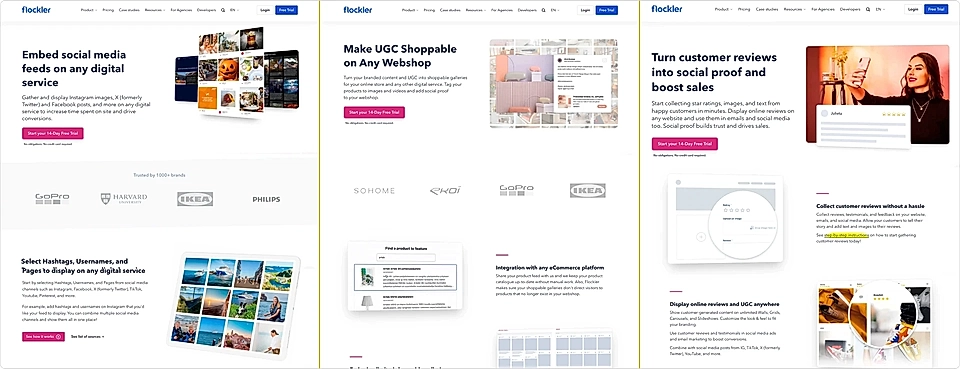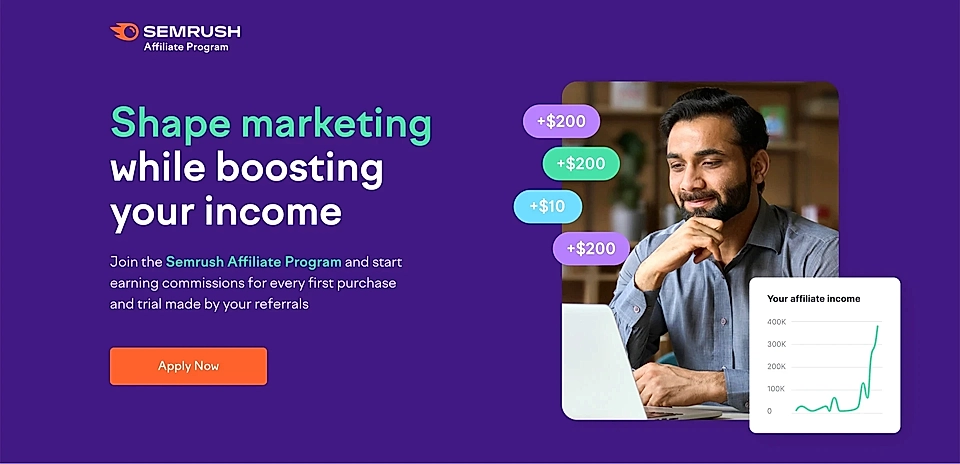7 landing page types every SaaS needs
Do you still remember the feeling of launching your first SaaS homepage and sharing it with the world?
I do.
But little did I know how many landing pages I’d launch over the next decade doing marketing for my B2B SaaS.
A lot.
Here are the most typical SaaS landing page types:
- Targeted audience
- Solution and feature-specific
- Paid advertising
- SEO
- Lead magnets
- Events, webinars, and podcasts
- Special offers
Let’s take a look at each of them in detail 👇🏻
- Targeted audience

When you visit a B2B SaaS website and navigate to the bottom of the page, you’ll often find sections like ‘Solutions’, ‘Industries’, and ‘Alternatives’.
While those sections are not necessarily the highest traffic pages of the B2B SaaS website, they are often the first destination your sales and customer support teams will recommend to their contacts.
If you want to increase your chances of conversion, your team will need landing pages responding to the most common questions like:
- Why should I choose your product over the [competitor name]?
- Do you have any examples in my industry?
- Does your service work for my specific use case?
- Solution and feature-specific
Your SaaS might initially have one key feature, and that’s fantastic! The product features section on your homepage will be just enough to explain your offering in detail.
Enjoy while it lasts.
Over time, your SaaS gravitates towards higher complexity, and your new features might also serve slightly different types of users.
For example, my previous SaaS business originally served as a product to curate social media posts. As logical next steps and based on the customer feedback, the offering expanded to e-commerce integrations, customer reviews, and content rights management.

A one-pager wasn’t able to communicate the benefits of each feature, and I created plenty of product landing pages.
- Paid advertising
If you thought the previous two points meant an overwhelming number of landing pages, things only get serious when you start paid advertising.
Many SaaS companies lose money daily driving traffic to their homepage from Google search Ads and other paid advertising channels. It’s unlikely that the generic message will resonate with the lead.
To maximize the number of conversions, your landing page will need to answer the user's intent.
If you drive traffic via LinkedIn, X, Facebook, etc., your landing page should closely match the ad copy and visuals.
Here’s an example 👇🏻

With Google Ads, your PPC landing page hero title and description should include a variation of the search term the user typed, followed by the benefits directly related to that use case.
It sounds simple and obvious, but most marketers don’t do it.
Why?
Well, every campaign and growth hacking test requires another landing page, and without tools like LandingRabbit, creating pages can be painful.
- SEO
While SEO predominantly requires long-form content, there are a couple of landing page ideas that can drive traffic via search engines:
- Glossary and definitions: at the time of writing, BigCommerce ranks #1 for the search term ‘social media campaign’ with their glossary page. Well done 👏
- Mini apps: through Semrush and your Google Ads data, you’ll always find search terms that look for a simple tool or generator. Veed.io’s wav to mp4 generator is a fantastic example of how to get a piece of the 'wav to mp4' search traffic.
- Partner pages: a search term related to your industry plus the name of your partner can be an efficient way of finding niche audiences. Aftership, a shipment tracking and return management platform, has built a partner landing page for all the major couriers. They rank in the top 10 for search terms such as ‘ups tracking’ and ‘fedex tracking’.

- Lead magnets
It’s no secret that B2B buyers often need tens of touch points before conversion. Online content, email outreach, cold calls, industry events – you name it.
One of the key landing page types for SaaS are lead magnets. Most often, they promote a downloadable guide or checklist, and your goal is to grow your newsletter subscriber list.
Not only does your landing page design and content need to be spot on, convincing users to leave their contact details, but the downloadable must be packed with truly valuable information.

By the way, when you combine lead magnets with a CRM like Hubspot, making sure your new lead will be automatically nurtured in the coming weeks and months, you might be onto something.
- Events, webinars, and podcasts
Events, webinars, and podcasts are often follow-up materials for your lead magnet. Converting users from an email newsletter to one of these will significantly increase their chances of becoming clients.
Recently, the ‘Confessions of a B2B marketer’ podcast suggested that to stand out from the noise, B2B companies should:
- Choose the CEO, head of sales, or someone else with industry knowledge, and start building a personal brand on social media.
- Once you’ve grown organic engagement and you start to see what’s working and what’s not, set up a newsletter and drive your organic audience towards it.
- When you’ve successfully built an audience for your newsletter, create a podcast to turn a portion of that audience into weekly listeners you can influence.
- Special offers
It used to be just B2C companies, but Black Friday offers are also here to stay for B2B SaaS.
Special offers are often time-limited for everyone or exclusive to a specific audience. The most common B2B examples are affiliate and agency partnership deals with a dedicated landing page.

Bonus: Localization
If you haven't grown anxious due to the number of landing page examples yet, multiply all the above with localized versions.
And it’s not just translating the content into different languages but also making sure the content and client examples resonate in the specific market.
In my previous company, privacy and GDPR were key concerns in certain market areas, and that had an immediate effect on the content and how we spoke about the topic. While the topic is equally important from a technical implementation and regulation perspective all over the world, the aspirations and level of detail are variable from one market to another.
*****
If you recently built your startup landing page, congrats! That page will be your first magnet, and it will give you a taste of SaaS marketing principles.
But as you gain more customer feedback and expand your product offering and marketing initiatives, you’ll learn about all seven landing page types (and beyond).
Are you looking to create landing pages but unsure where to start?
With LandingRabbit, you get help in planning the best possible page structure and content. Sign up for our 14-day free trial today and start publishing SaaS landing pages without the back-and-forth and guesswork.